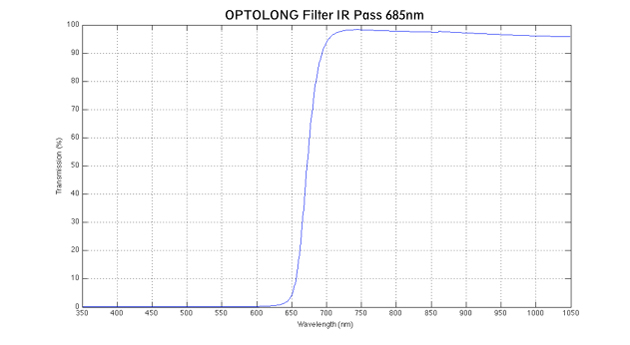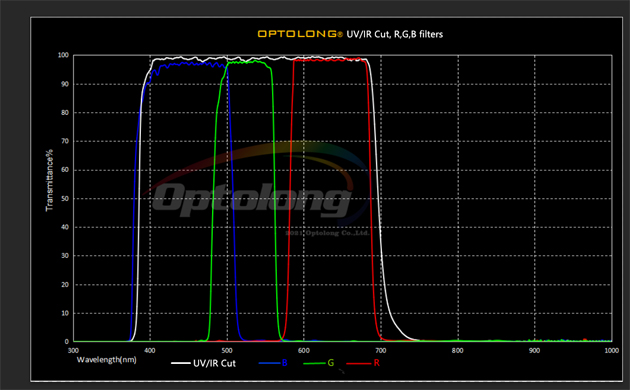Optolong Planetary filters kit including UV/IR Cut, R, G, B and IR685 filter, 5pcs filters in total. These five filters are boundled by "Solar System Seal".
What filters are used for Planetary photography?
Photography of planets and deepsky imaging, both are fine to use the combination of monocrom camera and filters. But slightly different, planets photography will not use what deepsky image use like Ha, SII, OIII filter. Planetary photography using filters often are IR, UV,filters, etc.
The main aim is to capture the specific spectrum, such as rich carbon dioxide. One of the most commoon filter we use is IR filter- infrared filter.
In nature, the longer the wavelength of light, the smaller affected by atmospheric seeing. Relatively, receiving the influence of red light, or infrared light is far less than the other bands.
Thus when we image the planet, we usually use an IR filter, transmits only infrared, or near-infrared ligth, in order to reduce the negative influence of seeing.
In visible light, photographers use the classical RGB filters. For Mercury, Venus, Uranus and Neptune, IR685 comes fist, and for Saturn, Jupiter, UV/IR Cut, R, G, B are good. However, the portfolio of IRRGB is popular.
IR685 Introduction
Optolong IR Pass685 filter is designed to block the most visible lights and can be used in IR-LRGB imaging to produce a sharper luminance image for the best planetary contrast as atmospheric seeing and distortion is much reduced at longer IR wavelengths. The advantage of the IR685 filter is to reduce the effects of atmospheric jitter.
The sensor of CCD or CMOS cameras i capable of detecting light in the 350nm -1100nm range including infrared wavelengths. Optolong IR685 cuts off the visible part of the spectrum and allows near infrared light to pass so that cause the most sensitive to bad seeing is rejected. It will highly improves images on visibility, contrast and details of planets and the moon. Besides, IR685 is usually used as a key factor of protfolio IRRGB.
Imaging Target:
IR685 is for imaging of bright planets, stars, and comet, like Uranus, Neptune, Jupiter, Saturn, Mars, Moon, et.
How to read the chart?
The horizontal axis is the Wavelength in Nanometers(nm).
The vertical axis is Transmission in %.
IR685 characteristic:
Tave: T>95%
Transmission area: 700-1100nm
Blocking are: 300-600nm
Blocking depth: bloked>99%
Surface quality: 60/40(Refer to MIL-O-13830)
Surface accuracy: λ/4
Parallelism: 30'
UV/IR Cut, R, G, B Filters Introduction
Optolong UV/IR Cut filter is designed for ultraviolet and infrared wavelength blocking to improve sharepmess of the image as most of the optics are designed for the visible spectrum, because it's very difficult to creat a lens with the same focal point for the visible and IR spectrum.
It is used on a digital camera and teh video, which do not have an IR protection filter toward an image sensor or were remodeled. This is important because unfilterted CCD and CMOS sensors are extremely susceptible to UV and IR rays just outside the visible spectrum that can have a very negative impact on image quality.
Optolong RGB set divides the spectrum into its components red, gree and blue.
RGB, parfocal: 1:1:1
Creat images in their true original colors showing a wealth of natural detail;
Steep bandpass filters to eliminate UV and IR interference;
UV/IR Cut, Red, Green, and Blue filters to reproduce the star's color;
Main use
In visible light, photograhers are absolutely using the classical RGB fiters. If you have Optolong LRGB filters, just try R filter for moon photography, which will be a good promotion. if you want more clear details fo the Moon, then consider Optolong IR685 filter seriously.
Suitable for color CMOS and CCD cameras and modified DSLRs;
Available to assist in focusing;
Act as an outstanding dust shield, which prevents the possibility of dust settling on the lens when long time exposure.
How to reach the chart?
The horizontal axis is the Wavelength in Nanometers(nm).
The vertical axis is Transmission in %.
The WHITE line shows the transmission of the UV/IR Cut filter. R filters line is shown in RED. G filter line is shown in GREEN. And the B filter line is showen in BLUE.
PACKING
Outer Box: silve box
Plastic Box: PP material
Lining: imported high pressure white EVA material


Home
Contact Us
Happy Customers
Our History
Terms and Conditions
Privacy Policy
Refund Policy
Shipping Policy
Pay
STARTRACKER [ India ]
EXPLORE SCIENTIFIC [ USA ]
G.S.O. [ Taiwan ]
Goto Mounts / Tripods [ U.S.A ]
BRESSER [ Germany ]
William Optics [ Taiwan ]
DWARF LAB [ China ]